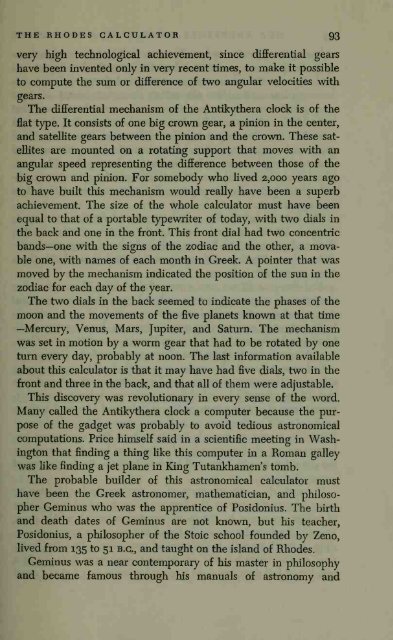Create successful ePaper yourself
Turn your PDF publications into a flip-book with our unique Google optimized e-Paper software.
THE RHODES CALCULATOR 93<br />
very high technological achievement, since differential gears<br />
have been invented only in very recent times, to make it possible<br />
to compute the sum or difference of two angular velocities with<br />
gears.<br />
The differential mechanism of the Antikythera clock is<br />
of the<br />
flat type. It consists of one big crown gear, a pinion in the center,<br />
and satellite gears between the pinion and the crown. These satellites<br />
are mounted on a rotating support that moves with an<br />
angular speed representing the difference between those of the<br />
big crown and pinion. For somebody who lived 2,000 years ago<br />
to have built this mechanism would really have been a superb<br />
achievement. The size of the whole calculator must have been<br />
equal to that of a portable typewriter of today, with two dials in<br />
the back and one in the front. This front dial had two concentric<br />
bands—one with the signs of the zodiac and the other, a movable<br />
one, with names of each month in Greek. A pointer that was<br />
moved by the mechanism indicated the position of the sun in the<br />
zodiac for each day of the year.<br />
The two dials in the back seemed to indicate the phases of the<br />
moon and the movements of the five planets known at that time<br />
—Mercury, Venus, Mars, Jupiter, and Saturn. The mechanism<br />
was set in motion by a worm gear that had to be rotated by one<br />
turn every day, probably at noon. The last information available<br />
about this calculator is tliat it may have had five dials, two in the<br />
front and three in the back, and that all of them were adjustable.<br />
This discovery was revolutionary in every sense of the word.<br />
Many called the Antikythera clock a computer because the purpose<br />
of the gadget was probably to avoid tedious astronomical<br />
computations. Price himself said in a scientific meeting in Washington<br />
that finding a thing like this computer in a Roman galley<br />
was like finding a jet plane in King Tutankhamen's tomb.<br />
The probable builder of this astronomical calculator must<br />
have been the Greek astronomer, mathematician, and philosopher<br />
Geminus who was the apprentice of Posidonius. The birth<br />
and death dates of Geminus are not known, but his teacher,<br />
Posidonius, a philosopher of the Stoic school founded by Zeno,<br />
lived from 135 to 51 B.C., and taught on the island of Rhodes.<br />
Geminus was a near contemporary of his master in philosophy<br />
and became famous through his manuals of astronomy and

















